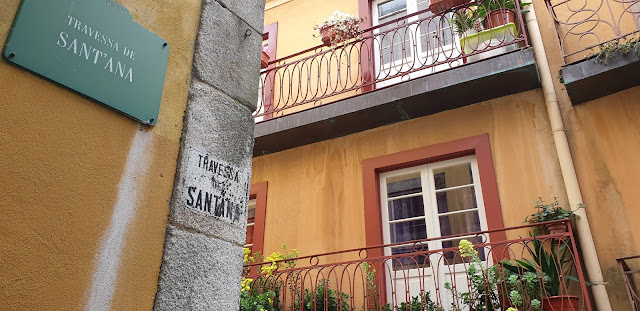I can't remember the number of times I've used the word beautiful to describe Lisbon.
The azulejo-clad buildings are beautiful.
The views from the Miradouros overlooking the terracotta roofs are beautiful.
The calçadas portugesa are beautiful.
The pastel coloured walls of Alfama are beautiful.
The orange trees (was so happy to see one!) are beautiful.
Truly, Lisbon is beautiful.
The azulejo-clad buildings are beautiful.
The views from the Miradouros overlooking the terracotta roofs are beautiful.
The calçadas portugesa are beautiful.
The pastel coloured walls of Alfama are beautiful.
The orange trees (was so happy to see one!) are beautiful.
Truly, Lisbon is beautiful.
 | |
|
In today's walking tour, we visited four neighborhoods in total - Baixa (the low district), Chiado (the shopping district) , Barrio Alto (the upper district) and Alfama (the oldest neighborhood). Four neighborhoods?! I'm surprised we covered that much ground in 3 hours, but then again, Lisbon is compact and very walkable.
Our first stop was Carmo Convent. On first glance, what stands out is a missing roof. Here we learnt of the devastating earthquake that hit Lisbon in 1755 and the ruins are a reminder of the what transpired during that tragedy.
Our first stop was Carmo Convent. On first glance, what stands out is a missing roof. Here we learnt of the devastating earthquake that hit Lisbon in 1755 and the ruins are a reminder of the what transpired during that tragedy.
 |
| Carmo Convent at night |
On 1 November 1755, an earthquake of magnitude 9 hit the city of Lisbon and destroyed many parts of the city. As per tradition on All Saints Day, the citizens lit candles in their house to prepare for the celebrations. As the tremors shook, the roofs fell and walls collapsed, the flames from the candles ignited a fire and soon the city was engulfed in flames. The estimated death toll was about 30,000–40,000.
Quite ironically, the non-Christians (by virtue of them not being church-goers) living in Alfama survived the earthquake. And for that, we must thank God because a part of history is preserved and we get a glimpse of what Lisbon was originally like, before it was rebuilt.
We continued walking from Chiado to Alfama and soon reached in about 10 minutes. Alfama is on a much higher plane and the houses were made of stone, two possible reasons why the neighborhood survived the earthquake.
 |
| An old house in Alfama. |
Comparing Baixa/Chiado and Alfama by just taking an aerial view of the two settlement plans, you'll come to realise how distinct these two neighbourhoods are.
Baixa is structured, linear and grid-like, (as a result of the rebuilt) while Alfama is has a more clustered plan, like a labyrinth with alleyways. Suffice to say, it's easy to get lost and Google Maps is quite impractical there.
We walked further and we see the houses and get a glimpse of everyday life here in Alfama. Our local guide tells us that the community spirit is strong there - locals do things together like wash their clothes together in a large basin and hang their clothes to dry in the open and talk to neighbours across the streets from their flats.
 |
| Crocheted tree in Alfama |
The sights, sounds and smells are so different from the city and the feeling is like that of home. Our guide spontaneously asked us if we'd like to try some Ginjinha, a sour cherry wine and she takes us to a lady selling homemade Ginjinha, which we see her take from the fridge of her house. It's been brewed for 6 months.
 |
| Homemade Ginjinha for €1 |
As I walk past the streets, we see some photographs of locals on the streets outside their houses, in their trade or line of business. Taken by an English photographer, Camilla Watson, they were a tribute to the people of Alfama who make this corner special.
Alfama is a meeting of old and new - with old historic houses and also modern street art as well. Called the Crono Project, the walls were blank canvas for artists to inject colour and energy into the neighbourhood, as well as turn abandoned buildings into art galleries.
Sadly, our guide shared that because of mass tourism and gentrification, some locals in the neighbourhood were vacated or asked to move out. Some of the old houses have been converted into apartments or Airbnb's and I feel is a bit sad now that I think about it. I would imagine it's equivalent to the Peranakan houses along Joo Chiat in Singapore.
In any case, I really enjoyed touring around Alfama. The people there are friendly and will wave at you and say hi to you if you do the same to them.
























































